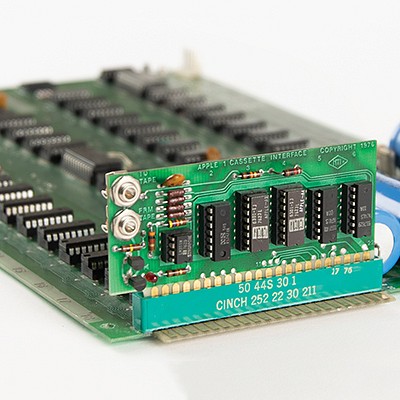Del Yocam's NeXTstation Color Computer (Addressed to Steve Jobs) and Peripherals
Two ways to bid:
- Leave a max absentee bid and the platform will bid on your behalf up to your maximum bid during the live auction.
- Bid live during the auction and your bids will be submitted real-time to the auctioneer.
Bid Increments
| Price | Bid Increment |
|---|---|
| $0 | $5 |
| $50 | $10 |
| $200 | $25 |
| $500 | $50 |
About Auction
Aug 24, 2023
RR Auction support@rrauction.com
- Lot Description
Remarkable NeXTstation Color computer set, personally-owned by Apple executive Del Yocam, who was the executive vice president and general manager of the Apple II group (1983-1985), Apple's first chief operating officer (COO) (1986-1988), and president of Apple Pacific (1989). Includes the NeXTstation Color workstation computer, NeXT MegaPixel 21-inch Color Display, NeXT Sound Box, NeXT CD-ROM Drive, and NeXT Color Printer, all in their original shipping boxes. Interestingly, the NeXTstation Color box is addressed to the company's famous founder: "Steve Jobs/NeXT CEO, 900 Chesapeake Drive, Building 1, 2nd Floor, Redwood City, CA 94063." The others are addressed to Del Yocam in Lake Oswego, Oregon. The printer and sound box both appear to be brand new, sealed in their original packaging. Additionally includes two NeXT keyboards and a modem with software for NeXT terminal emulation; no mouse is included.
This example of the NeXTstation Color, model no. N1200-0AE-16, features 16MB of DRAM, a 2.88MB floppy drive, and 400MB hard disk drive (the largest of the three available options). The NeXTstation Color was billed as a high-end workstation computer, combining 'near-photographic quality color and an object-oriented operating and development environment in an easy-to-use, professional color workstation.' The ability to display true color images made these systems ideal for publishing, presentations, graphic design, computer-aided design, data analysis, and virtually all other applications where color display capabilities were required. Its 'pizza box' form factor led to the computer being nicknamed 'the slab,' in contrast to the cube form of the original NeXT Computer.
After resigning from Apple in the fall of 1985, Steve Jobs founded the innovative NeXT project, a computer and software company aimed at the markets of business and higher education. The first NeXT Computer was introduced in 1988, and the smaller NeXTstation came two years later. While these computers encountered subpar sales, the object-oriented NeXTSTEP operating system and development environment proved highly influential. The OS offered an intuitive GUI with features like an application dock, true multitasking, drag-and-drop tools, large full-color icons, real-time scrolling, and other elements that are considered ubiquitous today. Unix derivatives incorporating NeXTSTEP would eventually power all of Apple's platforms, including the iPhone. Apple purchased NeXT in 1997 for $429 million and 1.5 million shares of Apple stock, with Steve Jobs, as part of the agreement, returning to the company he had co-founded in 1976. - Shipping Info
-
Bidder is liable for shipping and handling and providing accurate information as to shipping or delivery locations and arranging for such. RR Auction is unable to combine purchases from other auctions or affiliates into one package for shipping purposes. Lots won will be shipped in a commercially reasonable time after payment in good funds for the merchandise and the shipping fees are received or credit extended, except when third-party shipment occurs. Bidder agrees that service and handling charges related to shipping items which are not pre-paid may be charged to a credit card on file with RR Auction. Successful international Bidders shall provide written shipping instructions, including specified Customs declarations, to RR Auction for any lots to be delivered outside of the United States. NOTE: Declaration value shall be the item’(s) hammer price and RR Auction shall use the correct harmonized code for the lot. Domestic Bidders on lots designated for third-party shipment must designate the common carrier, accept risk of loss, and prepay shipping costs.
-
- Buyer's Premium



 EUR
EUR CAD
CAD AUD
AUD GBP
GBP MXN
MXN HKD
HKD CNY
CNY MYR
MYR SEK
SEK SGD
SGD CHF
CHF THB
THB







































